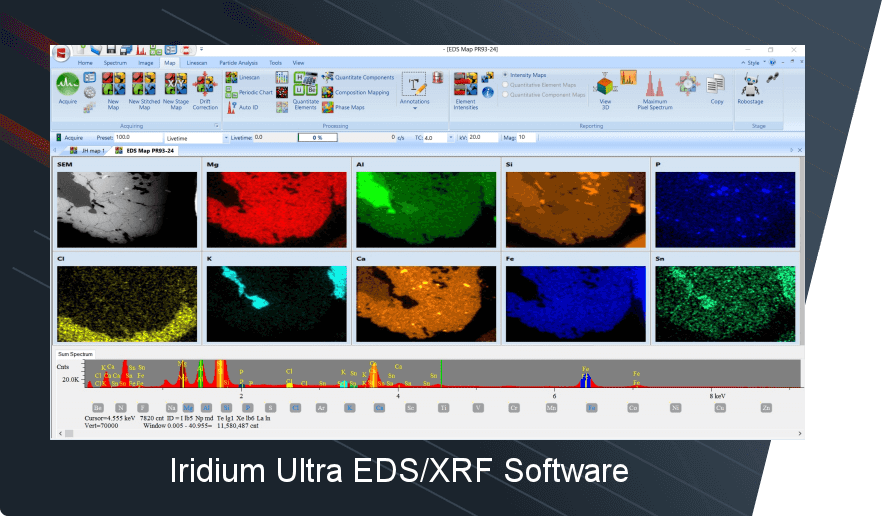Cigarettes are composed of several key materials, each designed to serve a specific function. From the tobacco blend to the filter and paper, each component contributes to the smoking experience. Using the Atlas M microXRF, IXRF Systems has conducted a detailed analysis to map the elemental composition of these materials, providing valuable insights into their structure and sources.
Components of a Cigarette
A cigarette is not a simple product; its design incorporates multiple elements to balance functionality, flavor, and production efficiency. The primary components include:
1. Tobacco Blend
- The core material of a cigarette consists of processed tobacco leaves
- Often includes natural and synthetic additives for flavor and combustion control.
2. Filter
- Primarily made of cellulose acetate fibers bound with a plasticizer, such as triacetin.
- Optional materials like activated carbon may be included for additional filtering.
3. Paper
- Thin wrapping paper, often treated with calcium carbonate to control burning and enhance structure.
- May include additives to adjust porosity and combustion behavior.
4. Glue
- Adhesives used to secure the filter and maintain the cigarette’s structural integrity.
5. Additives
- Optional ingredients like menthol or other flavor agents.
- Additives may also be used to modify smoke characteristics or enhance product appeal.
-
Findings from the Atlas M MicroXRF Analysis
Using its high spatial resolution (<10 μm), the Atlas M microXRF enabled precise identification of the elements present in each cigarette component. This method provided an accurate elemental breakdown, offering insights into material origins and potential implications.


Figures 1 and 2: 2D microXRF maps of a cigarette. Data was collected with the Atlas X microXRF.
Elemental Composition of Cigarettes
| Element | Likely Source | Role in Cigarette Components |
| Aluminum (Al) | Soil or fertilizers used in tobacco farming. | Found in tobacco and may reflect agricultural inputs. |
| Silicon (Si) | Soil or additives in filters and paper. | Present in both tobacco and filters, contributing to structural properties. |
| Chlorine (Cl) | Fertilizers, water, or chemical additives. | Found in tobacco and paper, possibly from agricultural or processing treatments. |
| Potassium (K) | Soil nutrients or additives in the tobacco blend. | Enhances combustion properties and contributes to consistent burning. |
| Calcium (Ca) | Calcium carbonate added to paper or absorbed from soil. | Stabilizes the burn rate and adds strength to paper and filters. |
| Titanium (Ti) | Titanium dioxide used in filter or paper materials. | Provides structural integrity and contributes to visual properties. |
| Copper (Cu) | Filter materials or manufacturing residues. | Trace amounts possibly related to foil or processing steps. |
| Zinc (Zn) | Metallic foil in filters or manufacturing processes. | Found in small amounts, associated with filter construction. |
| Arsenic (As) | Absorbed from soil or historical pesticide use. | A toxic element naturally absorbed by tobacco plants. |
Functional Role of Cigarette Components
The design of a cigarette balances performance with user experience:
- Tobacco Blend: Provides nicotine and flavor while maintaining a burn rate suitable for smoking.
- Filter: Captures some particulates and smoke constituents, though its effectiveness is limited.
- Paper: Ensures consistent combustion while supporting the structure of the cigarette.
- Glue and Additives: Provide stability and enhance sensory characteristics such as flavor or aroma.
Environmental Considerations
Many cigarette components have environmental impacts. Filters, composed of cellulose acetate fibers, are non-biodegradable and contribute significantly to global litter. Trace elements such as arsenic and zinc present in cigarette waste can leach into soils and waterways, further impacting ecosystems.
Atlas M MicroXRF: A Tool for Comprehensive Analysis
The Atlas M microXRF excels in analyzing multi-material systems like cigarettes, offering:
- Precise Elemental Mapping: High-resolution imaging detects and visualizes elemental distributions.
- Wide Elemental Range: Capable of detecting elements from carbon (C) to uranium (U).
- Versatility: Applicable to various fields, including environmental science, material analysis, and agriculture.
This capability makes the Atlas M microXRF a valuable instrument for investigating the composition of consumer products and their broader impacts.
Applications Beyond Cigarettes
The insights gained from this study highlight potential uses for the Atlas M microXRF across multiple industries:
- Agriculture: Monitoring soil and crop contaminants.
- Environmental Science: Assessing pollution sources and remediation needs.
- Material Science: Characterizing multi-material systems in industrial and consumer products.
Conclusion
The Atlas M microXRF offers a clear picture of cigarettes’ elemental makeup, revealing both the complexity of their design and the potential environmental and health implications. Understanding the composition of such products can inform discussions on sustainability, regulation, and waste management.
For more information on the Atlas M microXRF and its applications, visit IXRF Systems.


